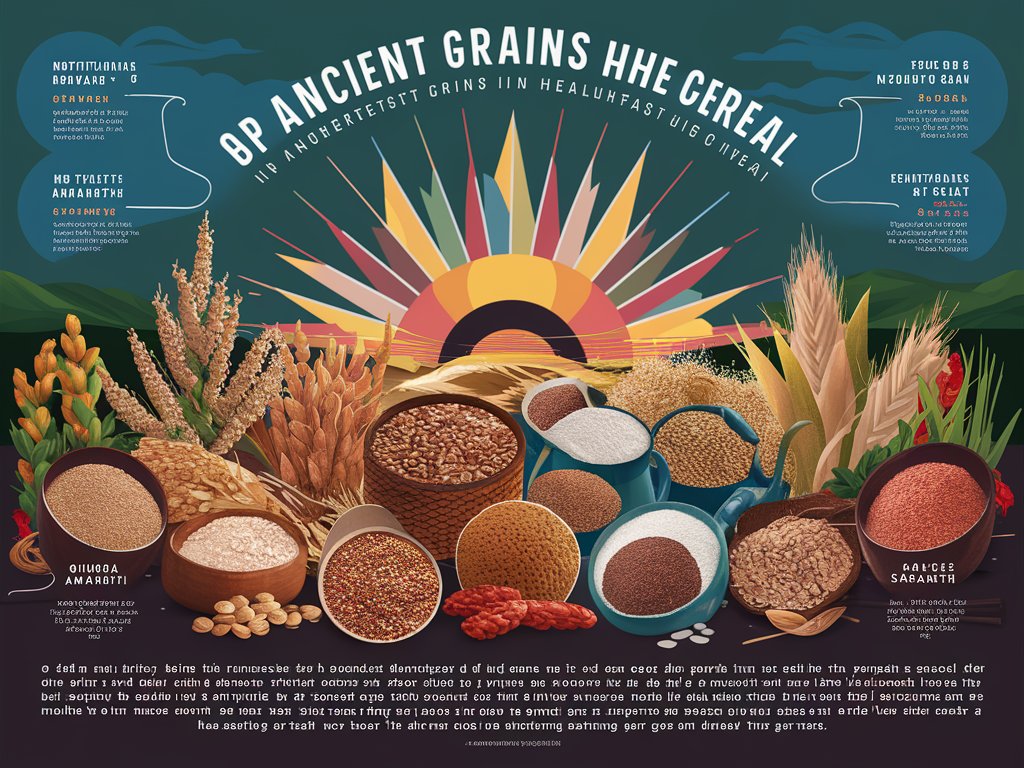In recent years, there has been a noticeable shift in dietary preferences towards more natural and wholesome food options. One of the most significant trends is the resurgence of ancient grains in our diets, particularly in breakfast cereals. These grains, which have been cultivated for thousands of years, offer a multitude of health benefits that modern grains often lack. They explores the nutritional advantages of incorporating ancient grains in a healthy cereal, the various types of ancient grains available, and why they are superior to more commonly consumed grains.
The Nutritional Powerhouse of Ancient Grains
Ancient grains are a group of cereals and seeds that have remained largely unchanged for millennia. Unlike modern grains, which have been modified for increased yield and resistance to pests, ancient grains are closer to their original form. This lack of modification often results in a more robust nutritional profile. Ancient grains are typically rich in fiber, protein, vitamins, and minerals, making them an excellent addition to any diet.
High Fiber Content
One of the standout features of ancient grains is their high fiber content. Fiber is essential for maintaining a healthy digestive system, regulating blood sugar levels, and lowering cholesterol. Whole grains such as quinoa, farro, and spelt are packed with dietary fiber, which helps promote a feeling of fullness and aids in weight management. For instance, a serving of quinoa contains about 5 grams of fiber, which is significantly higher than most refined grains.
Rich in Protein
Ancient Grains in a Healthy Cereal are also a great source of plant-based protein. Protein is crucial for building and repairing tissues, making enzymes and hormones, and supporting overall health. Amaranth and quinoa are particularly noteworthy for their high protein content, with quinoa offering all nine essential amino acids, making it a complete protein. This is especially beneficial for vegetarians and vegans who may struggle to get enough protein from their diet.
Packed with Vitamins and Minerals
In addition to fiber and protein, ancient grains are rich in essential vitamins and minerals. They are excellent sources of B vitamins, which are vital for energy production and brain function. They also provide important minerals such as magnesium, iron, and zinc. For example, teff, a tiny grain from Ethiopia, is incredibly rich in iron and calcium, which are critical for maintaining healthy bones and blood.
Low Glycemic Index
Many ancient grains have a low glycemic index (GI), meaning they have a slower impact on blood sugar levels. Foods with a low GI are digested and absorbed more slowly, leading to a gradual rise in blood sugar and insulin levels. This is particularly beneficial for individuals with diabetes or those looking to maintain stable energy levels throughout the day. Barley and farro are excellent examples of low-GI grains that can help manage blood sugar levels.
Types of Ancient Grains
There is a diverse range of ancient grains available, each with its unique flavor, texture, and nutritional benefits. Here are some of the most popular and nutritious ancient grains that can be found in healthy cereals.
Quinoa
Quinoa is often referred to as a “superfood” due to its exceptional nutrient profile. It is gluten-free, high in protein, and contains all nine essential amino acids. Additionally, quinoa is rich in magnesium, iron, fiber, and antioxidants. Its versatility and mild flavor make it a perfect addition to breakfast cereals, providing a nutritious start to the day.
Amaranth
Amaranth is another gluten-free grain that is packed with protein, fiber, and micronutrients. It is particularly high in lysine, an essential amino acid that is often lacking in other grains. Amaranth also contains anti-inflammatory compounds and has been linked to lower cholesterol levels. Its slightly nutty flavor and crunchy texture make it an excellent ingredient in cereals.
Farro
Farro is an ancient grain that has been cultivated for thousands of years in the Mediterranean region. It has a chewy texture and a nutty flavor, making it a delicious addition to cereals. Farro is rich in fiber, protein, magnesium, and zinc. It also has a low glycemic index, making it a good option for those looking to manage their blood sugar levels.
Teff
Teff is a tiny grain from Ethiopia that is incredibly nutrient-dense. It is an excellent source of protein, fiber, iron, and calcium. Teff is also rich in resistant starch, a type of carbohydrate that promotes healthy gut bacteria and improves blood sugar control. Its mildly sweet flavor makes it a great addition to breakfast cereals.
Spelt
Spelt is an ancient wheat variety that has a slightly sweet and nutty flavor. It is rich in fiber, protein, vitamins, and minerals, including manganese, phosphorus, and niacin. Spelt is easier to digest than modern wheat varieties and has a lower gluten content, making it a good option for those with mild gluten sensitivities.
Millet
Millet is a small, round grain that is highly nutritious and naturally gluten-free. It is rich in magnesium, phosphorus, and antioxidants. Millet has a mild, slightly sweet flavor and can be used in a variety of cereals to add nutritional value and a pleasing texture.
Kamut
Kamut, also known as Khorasan wheat, is an ancient grain with a rich, buttery flavor. It is high in protein, fiber, and essential fatty acids. Kamut is also a good source of selenium, zinc, and magnesium. Its chewy texture makes it a hearty addition to breakfast cereals.
Also Read: Discover Spooktacular Halloween Events Near Me
Why Choose Ancient Grains Over Modern Grains?
While modern grains such as wheat, corn, and rice are staples in many diets, they often lack the nutritional density of ancient grains. The refining process that modern grains undergo removes much of their fiber, vitamins, and minerals, leaving behind a product that is higher in calories and lower in nutrients. In contrast, ancient grains are typically consumed in their whole form, preserving their nutritional integrity.
Better Nutrient Profile
Ancient grains generally offer a better nutrient profile compared to modern grains. They are higher in protein, fiber, and essential vitamins and minerals. For example, a cup of cooked quinoa provides about 8 grams of protein and 5 grams of fiber, while a cup of white rice offers only about 4 grams of protein and 1 gram of fiber.
Lower Glycemic Index
Many ancient grains have a lower glycemic index than modern grains, which helps in maintaining stable blood sugar levels. This is particularly important for individuals with diabetes or those trying to manage their weight. Low-GI foods lead to a slower release of glucose into the bloodstream, providing sustained energy and reducing hunger.
Less Processing
Ancient grains are often less processed than modern grains. This means they retain more of their natural nutrients and have fewer additives. Consuming less processed foods is associated with numerous health benefits, including improved digestion, better heart health, and a lower risk of chronic diseases.
Environmental Benefits
Ancient grains can also be better for the environment. Many of these grains are more resilient to harsh growing conditions and require fewer inputs such as water and pesticides. This makes them a more sustainable choice compared to heavily cultivated modern grains.
Incorporating Ancient Grains into Breakfast Cereals
Incorporating ancient grains into breakfast cereals is a simple yet effective way to enhance your diet. Here are some tips on how to enjoy these nutritious grains in your morning routine.
Choose Whole Grain Cereals
When selecting breakfast cereals, look for options that list whole ancient grains as the primary ingredient. Whole grain cereals are less processed and retain more of their natural nutrients. Avoid cereals with added sugars and artificial ingredients.
Make Your Own Cereal Mix
One of the best ways to ensure you are getting the benefits of ancient grains is to make your own cereal mix. Combine your favorite ancient grains, such as quinoa, amaranth, and millet, with nuts, seeds, and dried fruits for a nutritious and delicious breakfast. This allows you to control the ingredients and avoid unwanted additives.
Try Hot Cereals
Hot cereals made from ancient grains are a comforting and nutritious breakfast option. Cook grains like quinoa, farro, or teff in water or milk until tender, and then add your favorite toppings such as fresh berries, nuts, and honey. This warm and hearty breakfast will keep you full and energized throughout the morning.
Experiment with Different Flavors and Textures
Ancient grains in a healthy cereal come in a variety of flavors and textures, so don’t be afraid to experiment. Mix and match different grains to find combinations that you enjoy. For example, you can blend the nutty flavor of farro with the mild sweetness of millet for a unique and tasty cereal mix.
Conclusion: Embrace the Ancient Grain Renaissance
The resurgence of ancient grains in our diets represents a return to more natural and nutrient-dense food options. By incorporating these grains into healthy cereals, we can enjoy their numerous health benefits, from improved digestion to better blood sugar control. Ancient grains in a healthy cereal such as quinoa, amaranth, farro, teff, spelt, millet, and kamut offer a superior nutritional profile compared to modern grains, making them an excellent choice for a wholesome breakfast. As we continue to prioritize our health and well-being, embracing ancient grains in our diets is a simple yet powerful step towards better nutrition.



